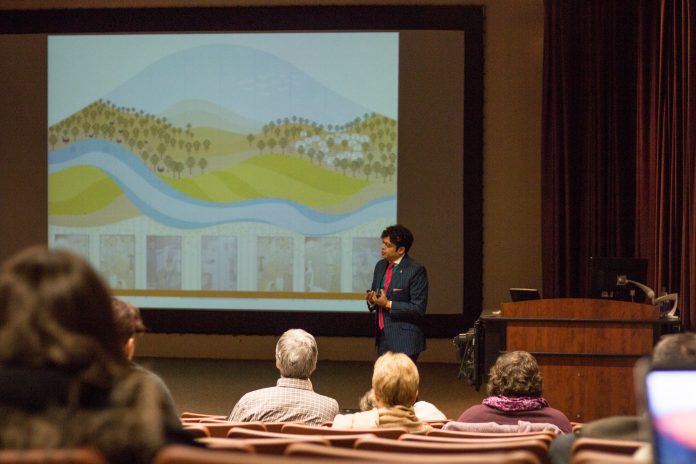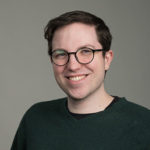On January 16, UFV, in partnership with The Reach Gallery, welcomed internationally acclaimed museologist George Jacob to its lecture theatre. Jacob, a man with a long history in the world of museums, started his presentation entitled Creating Cultural Capital: The Museum Industry from a Global Perspective by explaining that his industry is in need of more students to engage with it, study it, and eventually join it.
Jacob began his slideshow by speaking of his most high-profile project in this part of the world: acting as president and CEO of the recently launched Phillip J. Currie Dinosaur Museum near Grande Prairie, Alberta. The high profile museum had one of the fastest builds ever, at exactly 13 months, and hired most of its staff just two weeks before opening. Despite that, it won numerous awards and has drawn new attention to Grande Prairie.
“I got a call from Dan Aykroyd,” Jacob recalled, referring back to when he first became involved with the project. Aykroyd, he explained, had been in Alberta with his wife and daughters digging for dinosaur bones, and the family had been excited to find several. When they spoke to a local and learned of the plans for a museum, he’d asked “How can I help?” and — Jacob emphasized — he has followed through with multiple visits to the site throughout the process.
But the Phillip J. Currie Dinosaur Museum was hardly Jacob’s first project. After extensive schooling ranging from his native India to Toronto to Yale, his first role as a museum director was in Jaipur, India in the ‘80s. After that, the story of his career is a globe-spanning adventure, which he shared through stories and photos of his many projects. “Some of these come together in interesting ways you don’t expect when you go in,” he admitted. His stories included a time when, after being hired, he learned that he was the eighth director of a troubled project in Hawaii, with the previous ones lasting between two months and two days before quitting, or the difficulty of having an immense, intricate carpet woven for Virasat-e-Khalsa, a museum of Sikhism (coincidentally located not far from Chandigarh, India — home of UFV’s only international campus).
Jacob also spoke on the modern role and state of museums worldwide. In China, he said, there are plans to open 6,000 museums by 2028, with topics ranging from cartoons to fashion, from urban planning to sea shells. In the Middle East, there is a movement to build clusters of several museums, or even giant mega-museums, spurred on by an “incredible sense of hope and optimism” in the cultural industries. He showed slides of museums around the world, some of which were almost unimaginably massive like Ferrari’s Abu Dhabi island complex, which is visible from space and may be more aptly called a theme park.
There were two similarities that became apparent over the course of Jacob’s talk: one, a vast number of these institutions were designed by Canadian or American firms and individuals. Second, while they were all wildly varied in their design, many still had a similar ***feel in their appearance, of smooth glass or metal curving at sharp angles. “There’s a rise in a set of architecture increasingly called ‘eyegasm,’” Jacob mentioned offhandedly, resulting in quietly stifled chuckles from some audience members.
Size, however, is not a requirement for a notable museum according to Jacob. Museums of local history or even small three room installations like Croatia’s Museum of Broken Hearts have immense value in his eyes. When asked during the question period about how museums create cultural capital, he explained there are tangible and intangible benefits. The tangible benefits result in one of Jacob’s most used phrases of the afternoon, the “galvanization” of communities and economies. He explained how the Guggenheim Foundation building a museum in Bilbao, Spain revitalized the town, and how it can be as simple as updating the look of a building. The Petersen Automotive Museum in Los Angeles, once an imposing, almost industrial-looking building remodeled itself into a sleek red building wrapped in ribbons of stainless steel, and through that increased its ticket sales by 600 per cent.
The intangible benefit of museums, according to Jacob, can only be measured over time in the ways they make people and societies better. However, the word museum itself has changed to include less tangible topics in recent years. In particular, the topic of human rights. From one in Australia that is covered in Braille writing apologizing for the treatment of indigenous peoples, to one in Darfur which “brings theatre into the museum,” they’re using new approaches to tell their stories. Jacob warned that his next slide could be disturbing as he discussed the Darfur example, and then showed an image of dozens of nearly naked actors lying in a massive pool of blood. The room, and Jacob, went silent at the powerful image representing the devastating history of the region.
There are also both human rights museums and human rights concerns closer to home for us in Canada, Jacob pointed out. The Canadian Museum for Human Rights in Winnipeg featured prominently in his discussions, and while he praised some of its successes, he came across as critical of its 12-year build time and focus that ballooned from specifically the Holocaust to a general focus on human rights. He also spoke about the ethics of museums, saying that just a mile away from the “glass cocoon” of the museum, some of Canada’s poorest people suffer from our own atrocities. He emphasized the massive cost of such institutions, highlighting the complicated issue of balancing the concepts of helping and informing.
Jacob also made a point of highlighting the benefits of museums once again as his conversational question period wound down. To one inquiry about curation, he expressed the importance of ensuring museum’s stewards understand their responsibilities to pass along cultural artifacts to future generations, everything from languages not spoken anymore to cassette tapes never seen by some of today’s youth to the styles of jewellery his grandmother wore when he was a child. Museums are “not just a place where you have trophies,” he summarized. “There are stories behind those trophies.”
Jeff was The Cascade's Editor in Chief for the latter half of 2022, having previously served as Digital Media Manager, Culture & Events Editor, and Opinion Editor. One time he held all three of those positions for a month, and he's not sure how he survived that. He started at The Cascade in 2016.



